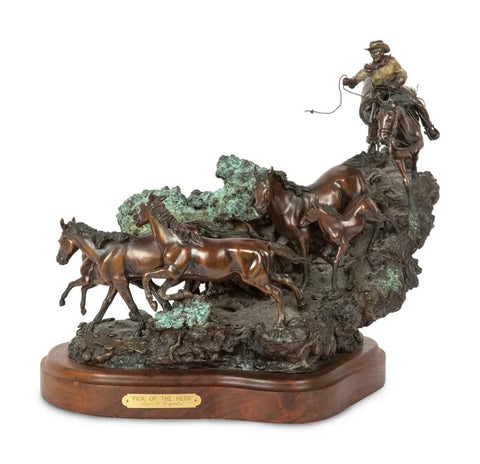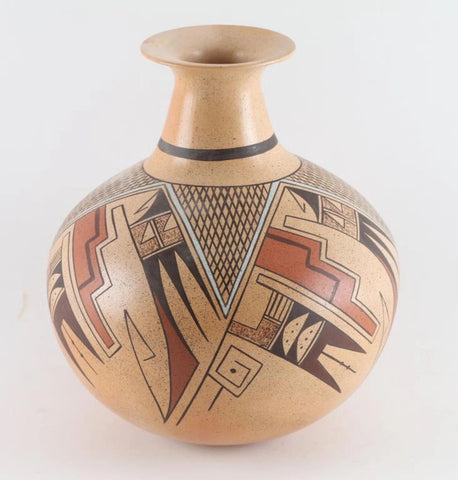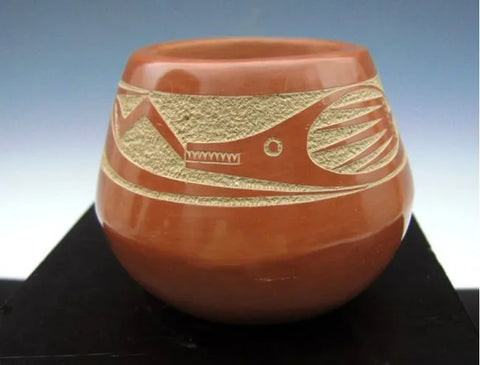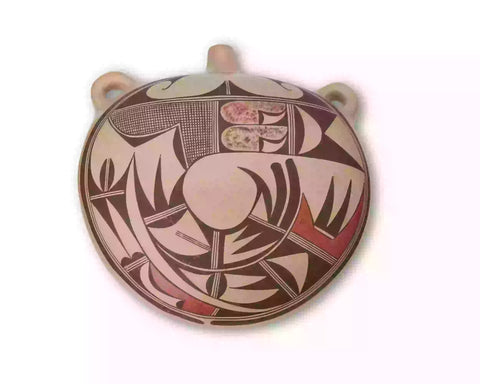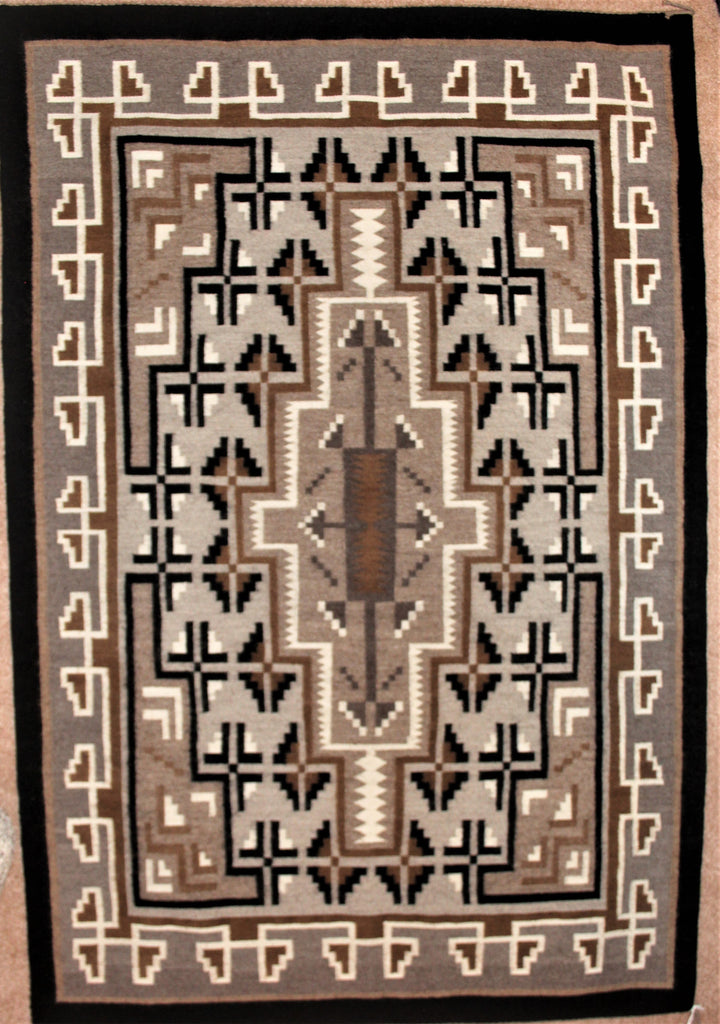
Mary C. Henderson, Exceptional Vintage Two Grey Hills, Navajo Weaving, Ca 1970's C 1747. SOLD
$ 4,500.00
Mary C. Henderson, Exceptional Vintage Two Grey Hills, Navajo Weaving, Ca 1970's C 1747.
Description: C 1747, Mary C. Henderson, Exceptional Vintage Two Grey Hills Navajo Weaving. Two Grey Hills area weaving in traditional style and colors. Woven by Mary C. Henderson, Ca 1970's. Very finely woven.
Dimensions: 39" x 58".
Condition: Excellent for its age.
Provenance: Tanner Chaney Gallery.
A Brief Social History of Navajo Weaving and a bit of historical context for a popular contemporary collectible.
There is an ageless beauty to Navajo weaving. Navajo weaving's are many things to people. Above all else, Navajo weaving's are masterworks, regardless of whose criteria of art is used to judge them. They are evocative, timeless portraits which, like all good art, transcend time and space. Navajo weaving has captured the imagination of many not only because they are beautiful, well-woven textiles but also because they so accurately mirror the social and economic history of Navajo people. Succinctly, Navajo women wove their life experiences into the pieces.
Navajo people tell us they learned to weave from Spider Woman and that the first loom was of sky and earth cords, with weaving tools of sunlight, lightning, white shell, and crystal. Anthropologists speculate Navajos learned to weave from Pueblo people by 1650. There is little doubt Pueblo weaving was already influenced by the Spanish by the time they shared their weaving skills with Navajo people. Spanish influence includes the substitution of wool for cotton, the introduction of indigo (blue) dye, and simple stripe patterning. Besides the "manta" (a wider-than-long wearing blanket), Navajo weavers also made a tunic-like dress, belts, garters, hair ties, men's shirts, breech cloths, and a "serape-style" wearing blanket. These blankets were longer-than-wide and were patterned in brown, blue and white stripes and terraced lines.
For more than a century, the products of Navajo looms were probably identical to those of their Pueblo teachers, but by the end of the 1700's Navajo weaving began its divergence. While Pueblo weavers remained conservative, Navajo weavers learned that wefts did not need to be passed through all the warps each time, but rather, by stopping at whatever point they wished they could create patterning other than horizontal bands. These "pauses" in Navajo weaving are often seen as "lazy-lines" (diagonal lines across the horizontal wefts) in finished pieces. By 1800, weavers were using this technique to create terraced lines and discrete design elements. Navajo weavers also demonstrated more willingness to use color than their Pueblo teachers.
Spanish documents describing the Southwest in the early 18th century mention Navajo weaving skills. By the 1700s Navajo weaving was an important trade item to the Pueblos and Plains Indian people. In 1844, Santa Fe Trail traveler Josiah Gregg reported, "a singular species of blanket, known as the Serape Navajo which is of so close and dense a texture that it will frequently hold water almost equal to gum-elastic cloth. It is therefore highly prized for protection against the rains. Some of the finer qualities are often sold among the Mexicans as high as fifty or sixty dollars each."
Blankets were traded great distances as evidenced by their appearance in Karl Bodmer's 1833 painting of a Piegan Blackfoot man (Montana) wearing what appears to be a first-phase Chief's blanket or an 1845 sketch of Cheyenne at Bent's Fort (Colorado) wearing striped blankets. Historic photographs illustrate that the desirability of blankets increased with the 19th century. Closer and more frequent trading partners included the Utes, Apaches, Comanches, and Pueblos.
The Spanish or Mexicans had never been able to reach a lasting peace with the Navajo. When Mexico ceded the Southwest to the United States in 1848, the "Navajo Problem" was also inherited. With a pronounced resolve, Kit Carson led a "Scorched Earth" campaign in 1863, destroying food caches, herds and orchards, ending in 8000 Navajo people surrendering. They were marched hundreds of miles to an arid, barren reservation, Bosque Redondo, at Fort Sumner in eastern NM.
For five years the people endured incarceration with shortages of supplies, food, and water. Their culture changed dramatically during this period, not least in weaving. To substitute for their lost flocks, annuities were paid which included cotton string, commercially-manufactured natural- and aniline-dyed yarns as well as manufactured cloth and blankets. These lessened the Navajo people's reliance on their own loom products. In 1867, four thousand Spanish-made blankets were distributed to the Navajos as part of their annuity payment. The combination of widespread availability of yarns and cloth and the influence of the Spanish Saltillo designs were probably a direct inspiration in the dramatic shift in weaving during the Bosque Redondo years, from the stripes and terraced patterns of the Classic period to the serrate or diamond style of the Transitional period. It is testimony to the resiliency of Navajo culture that a period of internment could produce a robust period of change and continuity in weaving.
In 1868, the Navajo were allowed to return to their beloved mesas and canyons. In exchange for their return they promised to cease aggression against neighboring peoples, and to settle and become farmers. Reservation life brought further dramatic changes to Navajo culture, including a growing reliance on American civilization and its products. The sale of weaving's in the next thirty years would provide an essential vehicle for economic change from barter to cash. Annuity goods included yarns, wool cards, indigo dye, aniline dyes, and various kinds of factory woven cloth. Skirts and blouses made of manufactured cloth replaced the woven two-piece blanket dress. Manufactured Pendleton blankets displaced hand-woven mantas and shoulder blankets so that by the 1890's, there was relatively little need for loom products in Navajo society.
US government-licensed traders began to establish themselves on the new Navajo Reservation. Whatever their motivation, adventure or commerce, the traders became the chief link between the Navajo and the non-Indian world.
Trading posts exchanged goods for Navajo products such as pinon nuts, wool, sheep, jewelry, baskets, and rugs. While wool and sheep were important to Navajo people for weaving and meat, they were also important to the economy beyond the Reservation. Wool was in great demand in the industrialized eastern US for coats, upholstery, and other products. Traders bought wool by the pound and sold it to wool brokers in Albuquerque and Las Vegas, New Mexico. The sheep purchased by traders were herded to the nearest rail head and on to the slaughterhouses. The herds grew substantially and it became more profitable for Navajo people to sell wool rather than utilize it in weaving.
The railroad reached Gallup, NM in 1882, establishing a tangible connection between the Navajos and the wider market, with the traders acting as middlemen. The completion of the railroad signaled the closing of the American Frontier which, in turn, stimulated a nationwide interest in collecting American Indian art. The railroad made travel to the vast reaches of the west easier and thus opened the area for tourists. The traders recognized these new markets and began to influence weaving by paying better prices for weaving's they thought more attractive to non-Indian buyers. This new market, coupled with the Navajo's decline in use of their hand woven products, infused new life into Navajo textile arts.
By the 1880's, trading posts were well established on the Navajo Reservation, and traders encouraged weaving of floor rugs and patterns using more muted colors which they thought would appeal to the non-Indian market. By 1920, many regional styles of Navajo weaving developed around trading posts. These rugs are often known by the area's trading post's name.
The history of Navajo weaving continues; over the past century, Navajo weaving has flourished, maintaining its importance as a vital native art to the present day. Virtually all the nineteenth and twentieth-century styles of blankets and rugs are still woven, and new styles continue to appear.
________________________________________
Thanks to Bruce Bernstein, former director, Museum of Indian Arts and Culture, Museum of New Mexico , Santa Fe
Originally appeared in The Collector's Guide to Santa Fe and Taos - Volume 11
Description: C 1747, Mary C. Henderson, Exceptional Vintage Two Grey Hills Navajo Weaving. Two Grey Hills area weaving in traditional style and colors. Woven by Mary C. Henderson, Ca 1970's. Very finely woven.
Dimensions: 39" x 58".
Condition: Excellent for its age.
Provenance: Tanner Chaney Gallery.
A Brief Social History of Navajo Weaving and a bit of historical context for a popular contemporary collectible.
There is an ageless beauty to Navajo weaving. Navajo weaving's are many things to people. Above all else, Navajo weaving's are masterworks, regardless of whose criteria of art is used to judge them. They are evocative, timeless portraits which, like all good art, transcend time and space. Navajo weaving has captured the imagination of many not only because they are beautiful, well-woven textiles but also because they so accurately mirror the social and economic history of Navajo people. Succinctly, Navajo women wove their life experiences into the pieces.
Navajo people tell us they learned to weave from Spider Woman and that the first loom was of sky and earth cords, with weaving tools of sunlight, lightning, white shell, and crystal. Anthropologists speculate Navajos learned to weave from Pueblo people by 1650. There is little doubt Pueblo weaving was already influenced by the Spanish by the time they shared their weaving skills with Navajo people. Spanish influence includes the substitution of wool for cotton, the introduction of indigo (blue) dye, and simple stripe patterning. Besides the "manta" (a wider-than-long wearing blanket), Navajo weavers also made a tunic-like dress, belts, garters, hair ties, men's shirts, breech cloths, and a "serape-style" wearing blanket. These blankets were longer-than-wide and were patterned in brown, blue and white stripes and terraced lines.
For more than a century, the products of Navajo looms were probably identical to those of their Pueblo teachers, but by the end of the 1700's Navajo weaving began its divergence. While Pueblo weavers remained conservative, Navajo weavers learned that wefts did not need to be passed through all the warps each time, but rather, by stopping at whatever point they wished they could create patterning other than horizontal bands. These "pauses" in Navajo weaving are often seen as "lazy-lines" (diagonal lines across the horizontal wefts) in finished pieces. By 1800, weavers were using this technique to create terraced lines and discrete design elements. Navajo weavers also demonstrated more willingness to use color than their Pueblo teachers.
Spanish documents describing the Southwest in the early 18th century mention Navajo weaving skills. By the 1700s Navajo weaving was an important trade item to the Pueblos and Plains Indian people. In 1844, Santa Fe Trail traveler Josiah Gregg reported, "a singular species of blanket, known as the Serape Navajo which is of so close and dense a texture that it will frequently hold water almost equal to gum-elastic cloth. It is therefore highly prized for protection against the rains. Some of the finer qualities are often sold among the Mexicans as high as fifty or sixty dollars each."
Blankets were traded great distances as evidenced by their appearance in Karl Bodmer's 1833 painting of a Piegan Blackfoot man (Montana) wearing what appears to be a first-phase Chief's blanket or an 1845 sketch of Cheyenne at Bent's Fort (Colorado) wearing striped blankets. Historic photographs illustrate that the desirability of blankets increased with the 19th century. Closer and more frequent trading partners included the Utes, Apaches, Comanches, and Pueblos.
The Spanish or Mexicans had never been able to reach a lasting peace with the Navajo. When Mexico ceded the Southwest to the United States in 1848, the "Navajo Problem" was also inherited. With a pronounced resolve, Kit Carson led a "Scorched Earth" campaign in 1863, destroying food caches, herds and orchards, ending in 8000 Navajo people surrendering. They were marched hundreds of miles to an arid, barren reservation, Bosque Redondo, at Fort Sumner in eastern NM.
For five years the people endured incarceration with shortages of supplies, food, and water. Their culture changed dramatically during this period, not least in weaving. To substitute for their lost flocks, annuities were paid which included cotton string, commercially-manufactured natural- and aniline-dyed yarns as well as manufactured cloth and blankets. These lessened the Navajo people's reliance on their own loom products. In 1867, four thousand Spanish-made blankets were distributed to the Navajos as part of their annuity payment. The combination of widespread availability of yarns and cloth and the influence of the Spanish Saltillo designs were probably a direct inspiration in the dramatic shift in weaving during the Bosque Redondo years, from the stripes and terraced patterns of the Classic period to the serrate or diamond style of the Transitional period. It is testimony to the resiliency of Navajo culture that a period of internment could produce a robust period of change and continuity in weaving.
In 1868, the Navajo were allowed to return to their beloved mesas and canyons. In exchange for their return they promised to cease aggression against neighboring peoples, and to settle and become farmers. Reservation life brought further dramatic changes to Navajo culture, including a growing reliance on American civilization and its products. The sale of weaving's in the next thirty years would provide an essential vehicle for economic change from barter to cash. Annuity goods included yarns, wool cards, indigo dye, aniline dyes, and various kinds of factory woven cloth. Skirts and blouses made of manufactured cloth replaced the woven two-piece blanket dress. Manufactured Pendleton blankets displaced hand-woven mantas and shoulder blankets so that by the 1890's, there was relatively little need for loom products in Navajo society.
US government-licensed traders began to establish themselves on the new Navajo Reservation. Whatever their motivation, adventure or commerce, the traders became the chief link between the Navajo and the non-Indian world.
Trading posts exchanged goods for Navajo products such as pinon nuts, wool, sheep, jewelry, baskets, and rugs. While wool and sheep were important to Navajo people for weaving and meat, they were also important to the economy beyond the Reservation. Wool was in great demand in the industrialized eastern US for coats, upholstery, and other products. Traders bought wool by the pound and sold it to wool brokers in Albuquerque and Las Vegas, New Mexico. The sheep purchased by traders were herded to the nearest rail head and on to the slaughterhouses. The herds grew substantially and it became more profitable for Navajo people to sell wool rather than utilize it in weaving.
The railroad reached Gallup, NM in 1882, establishing a tangible connection between the Navajos and the wider market, with the traders acting as middlemen. The completion of the railroad signaled the closing of the American Frontier which, in turn, stimulated a nationwide interest in collecting American Indian art. The railroad made travel to the vast reaches of the west easier and thus opened the area for tourists. The traders recognized these new markets and began to influence weaving by paying better prices for weaving's they thought more attractive to non-Indian buyers. This new market, coupled with the Navajo's decline in use of their hand woven products, infused new life into Navajo textile arts.
By the 1880's, trading posts were well established on the Navajo Reservation, and traders encouraged weaving of floor rugs and patterns using more muted colors which they thought would appeal to the non-Indian market. By 1920, many regional styles of Navajo weaving developed around trading posts. These rugs are often known by the area's trading post's name.
The history of Navajo weaving continues; over the past century, Navajo weaving has flourished, maintaining its importance as a vital native art to the present day. Virtually all the nineteenth and twentieth-century styles of blankets and rugs are still woven, and new styles continue to appear.
________________________________________
Thanks to Bruce Bernstein, former director, Museum of Indian Arts and Culture, Museum of New Mexico , Santa Fe
Originally appeared in The Collector's Guide to Santa Fe and Taos - Volume 11
Related Products
Sold out






